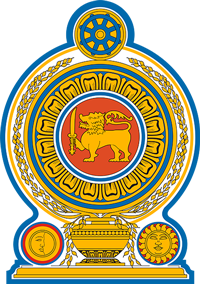Progress of Activities
01. Treasury Grant Funded Groundwater Monitoring and Studies
1.1 Long-term Groundwater Monitoring of the Coastal Sandy Aquifer extending from Colombo to Negombo (Rs. 0.25Mn)
Detailed hydrogeological studies of the coastal sandy aquifers extending from Colombo to Negombo have been commenced in 2011. The main aim of the study is to establish groundwater monitoring network with dedicated monitoring test boreholes in order to collect temporal data on groundwater quality changes and water table fluctuation. The test boreholes were constructed at most sensitive and vulnerable areas for groundwater deterioration due to over abstraction and industrial and domestic pollution. From 2011 to 2014, all the activities were completed and finally the groundwater monitoring network was established.
After completion of above activities, 78 test wells were selected as the long term monitoring points and started monitoring groundwater quality and water levels at dry and wet periods of the year and 2 transitional periods. This program was scheduled from 2015 and it should be continue for more years.
The progress up to July 2016 of the study are as follows:
Water samples were collected in the dry period and one transitional period. Water levels also measured parallel to sampling program.
| Activity | Number of samples | |
|---|---|---|
| 1st quarter | 2nd quarter | |
| Water sampling | 78 | 73 |
| Water quality analysis | 78 (Partial) | 0 (Full chemical analysis is going on) |
| Water level monitoring | 78 | 73 |
In the 1st quarter, water samples were analyzed for only 5 parameters. Those are, pH, EC, NO3, Fe and Alkalinity.
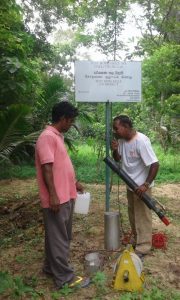
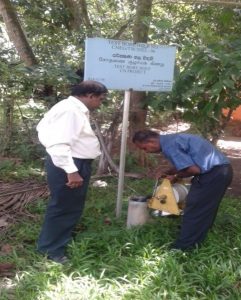
Collecting water samples and measuring water levels in the field
1.2 Long term groundwater monitoring and conducting of training programmes as awareness creation about water born health hazards and conducting water clinics.
This study covers the agricultural and CKDu (Chronic Kidney diseases) prevailing areas of Anuradhapura District and purpose of the study is to awareness creation and among the people of the area on groundwater quality problems and to conduct monitoring of groundwater quality to identify long term and temporal quality variations could be occurred due to natural and anthropogenic reasons.
The progress up to August 2016 of the study are as follows:
| No. | Activity | Annual Target | Progress up to August, 2016 |
|---|---|---|---|
| 01 | Groundwater Monitoring and Water Sampling | 200 Nos. data | 100 |
| 02 | Chemical analysis of water samples | 100 Samples | 46 |
| 03 | Conducting Awareness Programmes | 05 Nos. | 04 |
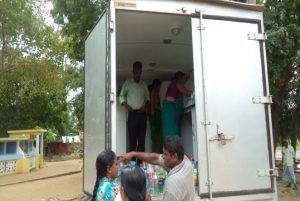
1.3 Hydrogeological Study in Limestone Aquifers in Mannar District
The need for groundwater assessment study arises from the urgent to establish a set up by which groundwater can be rationally used for domestic, industrial and agricultural production in environmentally friendly and sustainable manner. In this regard, appropriate groundwater development, use, management policies and guidelines are necessary. Without detail technical investigations and studies these targets cannot be achieved.
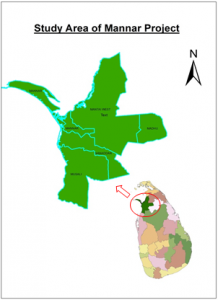
Groundwater resources have utilized in this country from times immemorial for domestic water supply from open dug wells, particularly rural areas where the water table is within a few meters below ground level in all parts of the country.
With the rapid development of industries and increment of rural population demand for clean water have been increased and scientific explorations for groundwater and construction of deep tube wells have been practiced over the last two decades.
At present, Mannar region is rapidly developed due to resettlement activities and the expanding of agricultural area especially in paddy cultivations. It is noted that groundwater development is undertaken by both the state and privet individuals. The recent trend shows increasing rates of groundwater extraction by the privet sector, including individual farmers, for drinking and small scale agricultural activities. At the same time, most of the tube wells and hand pumps were installed in rural areas to fulfill the domestic water requirements. On the other hand distribution of tube wells has not been found in uniform throughout the area due to low population and high salinity areas.
Groundwater table can be depleted as long term result of over extraction of water, by which also badly effects to natural vegetation of the areas. On the other hand, as groundwater is used for agricultural activities cause contamination of groundwater by agro-chemical pollutants which lead to degradation of the water quality, yield reduction to crops and health hazard to people who use the same water sources for their domestic requirements.
Major Activities and Results
Geophysical Investigations
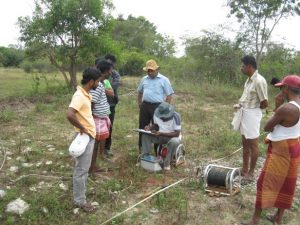 Vertical Electrical Soundings (VES) of the Wenner array were conducted in selected points to find out the vertical variation of the subsurface formations of the shallow and deep aquifers. The 15 numbers of vertical electrical sounding have been carried out covering the areas of Murunkan, Uilankulam, Wattakandal, Adampan, Nanaddan, Erawaddan, Wankalei, Thaladi, Silawathura and Paparakadanthan. The 10 designated locations were investigated and selected for test tube well constructions.
Vertical Electrical Soundings (VES) of the Wenner array were conducted in selected points to find out the vertical variation of the subsurface formations of the shallow and deep aquifers. The 15 numbers of vertical electrical sounding have been carried out covering the areas of Murunkan, Uilankulam, Wattakandal, Adampan, Nanaddan, Erawaddan, Wankalei, Thaladi, Silawathura and Paparakadanthan. The 10 designated locations were investigated and selected for test tube well constructions.
Drilling of exploration boreholes
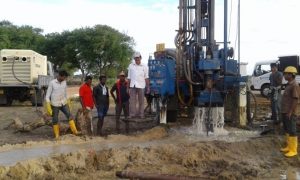 Based on the geophysical investigation and resistivity data interpretation results, 10 locations were selected for the test borehole drilling according to the project plan. There are 15 test bore wells have to be constructed during the year 2016 and at the end of July two test wells were completed.
Based on the geophysical investigation and resistivity data interpretation results, 10 locations were selected for the test borehole drilling according to the project plan. There are 15 test bore wells have to be constructed during the year 2016 and at the end of July two test wells were completed.
Water sampling and Chemical Analysis
About 127 water samples were collected from 96 shallow dug well sites of the shallow groundwater network and 31 constructed tube well sites. The water samples analysis in progress including full chemical analysis with Na+ and K+.
Pumping Test
Under this programme, 25 numbers Pumping Test have to be carried out in constructed tube wells in Mannar. Up to July 2016 two pumping tests had been completed and continue the activities.
1.4 Hydrogeological Study in Vavuniya and Kilinochchi Districts
The research was initiated in year 2013 under treasury grant. The project objective is to identify groundwater potential areas and to see the possibility of developing groundwater sources for future drinking water and small scale irrigated agricultural projects.
A specific objective of the study is to identify the aquifer parameters; it is extensions and demarcates the groundwater potential areas within the Vavuniya and Kilinochchi districts. It is expected to identify the groundwater sources for small scale irrigated agriculture and for drinking purposes of the people in both districts with the intention of up grading the living standards of the people.
From January 2016 to August 2016 following activities were completed under this project.
Table 01: Activities carried out during the year 2016 under the Vavuniya-Kilinochchi project.
| No. | Activity/ Description | No. of items |
|---|---|---|
| 01 | Water Sampling and well monitoring | 100 |
| 02 | Chemical Analysis of water samples | 51 |
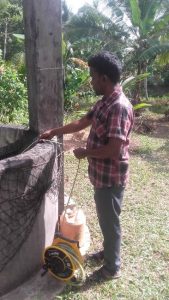
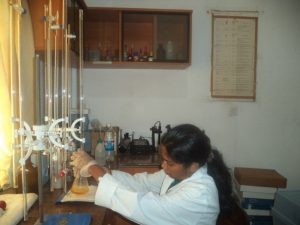
Measuring of Water level of a dug well Chemical Analysis of water samples
1.5 Development of Groundwater Monitoring Network for Jaffna Peninsula
Jaffna limestone aquifers are considered as one of the most important aquifers in the country as total water supply of Jaffna Peninsula provide by groundwater sources. Due to intensive agriculture and other anthropogenic activities, the Jaffna limestone aquifers are also vulnerable to easy contamination. Therefore, groundwater monitoring programs in Jaffna are conducting by Water Resources Board aiming to identifying groundwater level fluctuation, water quality changes, pollution levels, direct and indirect pollution sources and to check groundwater recharge possibilities within the Peninsula.
The Physical progress of this programmeis given in table (from January 2016 to July 2016)
| No. | Activity | Progress |
|---|---|---|
| 01 | Carry out groundwater investigations | 17 |
| 02 | Construction of test bore holes | 08 |
| 03 | Conducting of pumping tests | 06 |
| 04 | Water sampling and well monitoring | 212 |
| 05 | Chemical Analysis of water samples | 154 |
| 06 | Chemical analysis | 100 |
| 07 | Data analysis, interpretation and reporting | In progress |
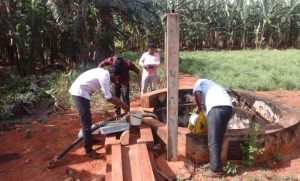
1.6 The Study on the direct and Indirect Impacts of the Climate Changes on the Coastal Aquifer System of Sri Lanka
Western Coastal Groundwater Aquifer Colombo – Weligama beach
To achieve the project objectives of this project following activities have been carried out during the period from January to August 2016
- Water sampling and well monitoring – 200 Nos
To identification of salinity level changes in coastal aquifer system of Sri Lanka through a proper groundwater monitoring network and to the determination of the fluctuation of fresh water-groundwater interface, we have selected 50 nos. of shallow wells in the western coastal zone which exist from Colombo to Weligama coastal strip (Figure 03). We have measured the water level and collected water sample with respect to monsoon seasons. At the end of August 2016, we have completed two monitoring events which fall for the Northeast monsoon season (27-01-2016 to 02-02-2016) and First inter-monsoon period (28-04-2015 to 03-05-2016).During this monitoring process, we measured groundwater level of the shallow wells and collected 50 nos. of water samples per event (total 100 nos. of water sample). Collected water sample for the northeast monsoon period was analyzed for 17 physical and chemical parameters and water samples of 1st inter-monsoon period were spatially analyzed.
- Carry out hydrogeological surveys -10 no
10 numbers of hydrogeological surveys has been completed along the western coastal strip
- Construction of test bore wells – 10 nos
Out of 10 numbers of tests bore wells, 5 numbers of test bore hole constructions have been completed within this study period
Conducting of pumping test on the constructed test bore wells (10 nos.), leveling of constructed test wells (10 nos.), the collection of 100 nos. of water samples (for southwest and 2nd inter – monsoon periods) and measuring of water level have to be completed during the rest of the year 2016.

Hydrogeological survey at Saddarmakaraviddiyathan piriwena, Panadura |
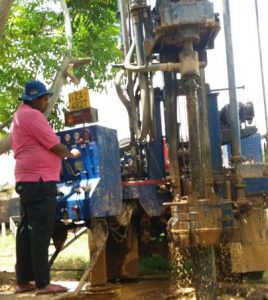
Test well drilling at Police station, Payagala |
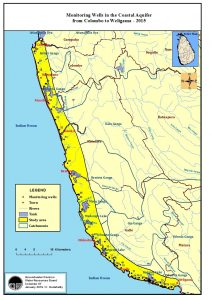
Established groundwater monitoring network areas, sampling and water level monitoring points (Colombo to Weligama coastal strip).
1.7 Identification of suitable areas for groundwater recharge in Sri Lanka (Phase 1 – Puttalam District)
The project objective is to identify the aquifer parameters, it’s extensions and the suitability of recharge groundwater system in Puttalam area and identification of suitable areas for groundwater recharge and increase the groundwater potential capacities of the aquifer systems of Puttalam area. From the year 2014 to 2015 following activities were completed and finally the groundwater monitoring network was established.
Activities completed in the year 2014 and 2015.
- Carryout hydrogeological investigations
- Test bore hole drilling
- Water sample analysis
- Pump testing
Following field activities were carried out in 2016 (From January to June).
- 60 well locations were monitored in the month of March- April for measure water levels and groundwater tested for EC.
- 56 water samples were collected on the month of June for analysis selected chemical parameters such as EC, Total Iron, Nitrate, TDS, Phosphate, Alkalinity and pH.
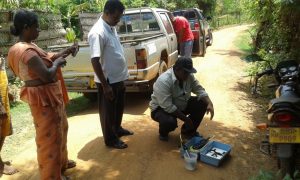
1.8 Water Quality Study in Chronic Kidney disease prevailing areas
At first patients with cronic Kidney disease were found in Anuradhapura district. Recently patients are identified in Ampara, Kurunegala, Pollonnaruwa and Badulla districts as well. It is believed intense use of agri chemicals as one cause for the disease. It is an ongoing project at the Provincial office, Puttalam. This study was started in 2015 and was continued in Polpithigama and Giribawa DS divisions in 2015. Also, under this study Galgamuwa and Mahawa pradeshiyasabha(including Galgamuwa, Ehetuwewa. Ambanpola and Mahawa DS divisions) areas, where are another two areas where CKD patients are frequently reported in Kurunegala district, have been selected for water quality studies in 2016.
Objective
- Study water quality and changes in CKDU prevailing areas in Kurunegala District
- Exchange data and assist researches integrating with CKDU studies carrying out institutions
Methodology
- Collection of data on CKDU patients
- Collection of water samples from water sources used by patients
- Collection of water sample for chemical analysis
- Preparation of water quality maps
1. Collection of data on CKDU patients
Patient distributory maps are prepared collecting data and information from Provincial Director of Health Office and District Directors Office.
2. Collection of water samples from water sources used by patients
50 water samples from each are collected at wet (February- March) and dry season (August – September) from drinking wells in Galgamuwa and Mahawa areas.Water samples are chemically analyzed for Arsenic (As) and Cadmium (Cd)
As the above 100 water samples are not sufficient for the preparation of water quality maps, it is expected to analyze water sources of drinking water projects under Divisional Secretary and Pradeshiya saba.
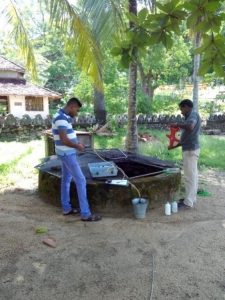

3. Collection of water sample for chemical analysis
Water samples are analyzed for Electrical conductivity (EC), TDS, pH, No3, Po4, Fe3+, hardness. Ca2+, So4, Cl, Mg2+, Na and K.Atomic Absorption Spectrophotometer is used for analyzing heavy metals
4. Preparation of water quality maps
Using GIS maps are prepared. Water clinics are conducted through mobile labs. Up to now 50 water samples were collected covering Galgamuwa Pradeshiya saba area and completed 20 samples for chemical analysis. In addition, information has been collected from 62 water sources of community water projects.
5 water samples were collected covering Mahawa Pradeshiya saba area and have been sent to the puttlam lab for analysis.It is expected to collect information on community water projects in the area.
Under this project following activities have been completed during January to July 2016.
| Activity | Galgamuwa Pradesiya Saba area | Mahawa Pradesiya Saba area | Total |
|---|---|---|---|
| Collection of Data on CKD patients | 40% Complete | 40% Complete | |
| A collection of water samples for Chemically analysis including Na+ and K+ | 50 Nos. | 50 Nos. | 100 Nos |
| A collection of data from existing CBO wells in Galgamuwa area. | 62 Nos. | – | 62 Nos. |
| Full chemically analysis | 20 Nos | – | 20 Nos |
Study water quality in Pollonnaruwa and Trincomalee districts areas
The project was started in 2014 covering whole Polonnaruwa & Trincomalee districts. Collection of data regarding the patients and random sampling in Polonnaruwa district have been completed in the consequent years of 2014 & 2015.
Activities carried out during the year 2016 under the CKD project in Polonnaruwa district is as follows;
| Activity | Total |
|---|---|
| Carryout Hydrogeological Investigations | 06 (Elahera, Lankapura, Welikanda, Dimbulagala & Hingurakgoda) |
| Construction of Test Wells | 05 (Elahera,Lankapura,Welikanda,Dimbulagala&Hingurakgoda) |
1.9 Groundwater Assessment of Kirindi Oya Basin
This study was started in 2015 to assess the groundwater in the basin qualitatively and quantitatively.
The achievements under this target so far are as follow:
| No. | Activity | Progress |
|---|---|---|
| 01 | Carry out groundwater investigations | 08 |
| 02 | Construction of test bore holes | 02 |
| 03 | Levelling of monitoring well points | – |
| 04 | Water sampling | 50 |
| 05 | Chemical Analysis | – |
| 06 | Data analysis, interpretation and reporting | In progress |
1.10 Groundwater Assessment of Kelani Ganga Basin
This study covers the upper part of Kelani river basin and steps have been taken to collect important groundwater data qualitatively and quantitatively. Those data will be utilized to development of Kelani river basin in future. From January 2016 to August 2016, following activities were completed under the project work.
| No | Activity/Description | No. of Item | Remarks |
|---|---|---|---|
| 01 | Collection of Water Samples from Water Sources | 41 | Water samples were collected from dug wells, streams and Water Falls. |
| 02 | Chemical Analysis of Water Samples | Nil | Partly completed. Analysis reports received for 100 samples collected in year 2015 |
| 03 | Geophysical Surveys to locate test wells | 01 | – |
| 04 | Rainfall and Evaporation data | – | Rainfall data covering entire basin area was collected |
1.11 Development of groundwater resources in the districts of dry zone area by construction of deep wells, pumps and water filters installation for emergency use
The main objective of this project is to provide safe and clean drinking water to the rural community who are living in most scarce and drought-stricken areas in Sri Lanka. During the period from January 2016 to July 2016 following activities were completed in Mulative and Moneragala districts.
| No | Activity | Annual Target | Progress |
|---|---|---|---|
| 01 | Carry out groundwater investigations | 20 | 05 |
| 02 | Construction of test bore holes | 20 | 05 |
| 06 | Chemical analysis | 10 | 02 |
| 07 | Data analysis, interpretation and reporting | In progress | In progress |
1.12. Rehabilitation of Hand pumps in Dry zone area
This program was carried out to rehabilitate old hand pump installed in Badulla, Moneragala and Hambantota Districts. Following activities were completed during the period from January 2016 to June 2016.
- No. hand pump tube wells repaired : 64
- No. of tube well cleaning : 59

